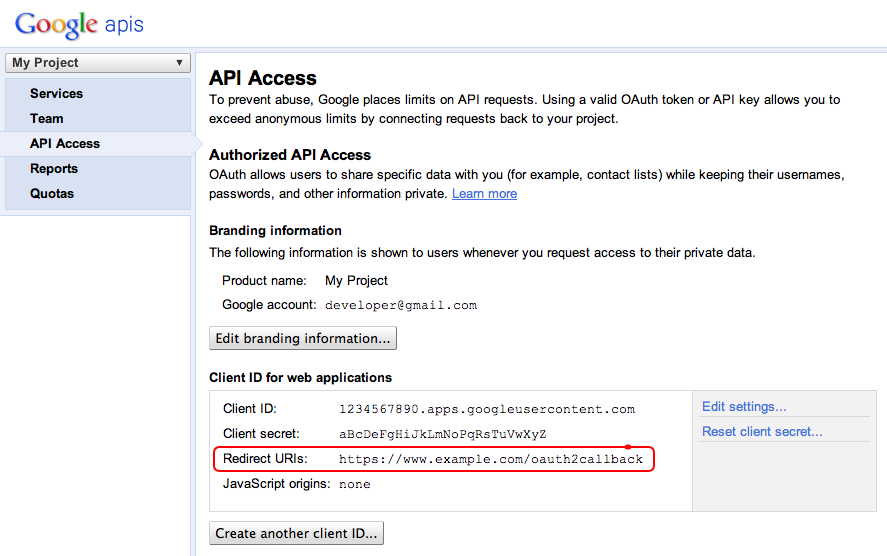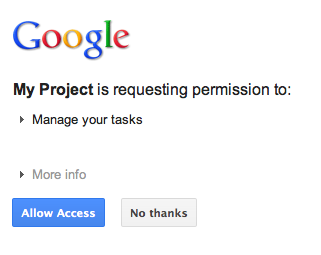เอกสารนี้อธิบายวิธีใช้งานตัวแฮนเดิล Callback สำหรับการให้สิทธิ์ OAuth 2.0 โดยใช้เซิร์ฟเล็ต Java ผ่านเว็บแอปพลิเคชันตัวอย่างที่จะแสดงงานของผู้ใช้โดยใช้ Google Tasks API แอปพลิเคชันตัวอย่างจะขอสิทธิ์ในการเข้าถึง Google Tasks ของผู้ใช้ก่อน จากนั้นจะแสดงงานของผู้ใช้ในรายการงานเริ่มต้น
ผู้ชม
เอกสารนี้ออกแบบมาเพื่อผู้ที่คุ้นเคยกับสถาปัตยกรรมเว็บแอปพลิเคชัน Java และ J2EE และขอแนะนําให้ทราบถึงขั้นตอนการให้สิทธิ์ OAuth 2.0
เนื้อหา
หากต้องการได้รับตัวอย่างหลายๆ ขั้นตอนที่สมบูรณ์ดังกล่าว คุณจะต้องทำดังนี้
- ประกาศการแมปเซิร์ฟเล็ตในไฟล์ web.xml
- ตรวจสอบสิทธิ์ผู้ใช้ในระบบและขอสิทธิ์ในการเข้าถึง Tasks
- ฟังรหัสการให้สิทธิ์จากปลายทางการให้สิทธิ์ของ Google
- แลกเปลี่ยนรหัสการให้สิทธิ์เพื่อรีเฟรชและโทเค็นเพื่อการเข้าถึง
- อ่านงานของผู้ใช้และแสดง
ประกาศการแมปเซิร์ฟเล็ตในไฟล์ web.xml
เราจะใช้เซิร์ฟเล็ต 2 ตัวในแอปพลิเคชันของเรา
- PrintTasksTitlesServlet (แมปกับ /): จุดแรกเข้าของแอปพลิเคชันที่จะจัดการการตรวจสอบสิทธิ์ของผู้ใช้และจะแสดงงานของผู้ใช้
- OAuthCodeCallbackHandlerServlet (แมปกับ /oauth2callback): Callback ของ OAuth 2.0 ที่จัดการการตอบกลับจากอุปกรณ์ปลายทางการให้สิทธิ์ OAuth
ด้านล่างคือไฟล์ web.xml ซึ่งแมปเซิร์ฟเล็ต 2 รายการนี้กับ URL ในแอปพลิเคชันของเรา
<?xml version="1.0" encoding="UTF-8"?>
<web-app version="2.5" xmlns="http://java.sun.com/xml/ns/javaee"
xmlns:xsi="http://www.w3.org/2001/XMLSchema-instance"
xsi:schemaLocation="http://java.sun.com/xml/ns/javaee http://java.sun.com/xml/ns/javaee/web-app_2_5.xsd">
<servlet>
<servlet-name>PrintTasksTitles</servlet-name>
<servlet-class>com.google.oauthsample.PrintTasksTitlesServlet</servlet-class>
</servlet>
<servlet-mapping>
<servlet-name>PrintTasksTitles</servlet-name>
<url-pattern>/</url-pattern>
</servlet-mapping>
<servlet>
<servlet-name>OAuthCodeCallbackHandlerServlet</servlet-name>
<servlet-class>com.google.oauthsample.OAuthCodeCallbackHandlerServlet</servlet-class>
</servlet>
<servlet-mapping>
<servlet-name>OAuthCodeCallbackHandlerServlet</servlet-name>
<url-pattern>/oauth2callback</url-pattern>
</servlet-mapping>
</web-app>
ตรวจสอบสิทธิ์ผู้ใช้ในระบบและขอสิทธิ์ในการเข้าถึงงาน
ผู้ใช้เข้าสู่แอปพลิเคชันผ่านทางราก "/" URL ที่แมปกับเซิร์ฟเล็ต PrintTaskListsTitlesServlet ในเซิร์ฟเล็ตดังกล่าว จะมีการดำเนินการต่อไปนี้
- ตรวจสอบว่าผู้ใช้ผ่านการตรวจสอบสิทธิ์ในระบบหรือไม่
- ถ้าผู้ใช้ไม่ผ่านการตรวจสอบสิทธิ์ ระบบจะเปลี่ยนเส้นทางไปยังหน้าการตรวจสอบสิทธิ์
- หากผู้ใช้ตรวจสอบสิทธิ์แล้ว เราจะตรวจสอบว่ามีโทเค็นการรีเฟรชอยู่ในพื้นที่เก็บข้อมูลของเราแล้วหรือยัง ซึ่งจัดการโดย OAuthTokenDao ด้านล่าง หากไม่มีโทเค็นการรีเฟรชสำหรับผู้ใช้ แสดงว่าผู้ใช้ยังไม่ได้ให้สิทธิ์แอปพลิเคชันในการเข้าถึงงาน ในกรณีนี้ ระบบจะเปลี่ยนเส้นทางผู้ใช้ไปยังปลายทางการให้สิทธิ์ OAuth 2.0 ของ Google
package com.google.oauthsample;
import ...
/**
* Simple sample Servlet which will display the tasks in the default task list of the user.
*/
@SuppressWarnings("serial")
public class PrintTasksTitlesServlet extends HttpServlet {
/**
* The OAuth Token DAO implementation, used to persist the OAuth refresh token.
* Consider injecting it instead of using a static initialization. Also we are
* using a simple memory implementation as a mock. Change the implementation to
* using your database system.
*/
public static OAuthTokenDao oauthTokenDao = new OAuthTokenDaoMemoryImpl();
public void doGet(HttpServletRequest req, HttpServletResponse resp) throws IOException {
// Getting the current user
// This is using App Engine's User Service but you should replace this to
// your own user/login implementation
UserService userService = UserServiceFactory.getUserService();
User user = userService.getCurrentUser();
// If the user is not logged-in it is redirected to the login service, then back to this page
if (user == null) {
resp.sendRedirect(userService.createLoginURL(getFullRequestUrl(req)));
return;
}
// Checking if we already have tokens for this user in store
AccessTokenResponse accessTokenResponse = oauthTokenDao.getKeys(user.getEmail());
// If we don't have tokens for this user
if (accessTokenResponse == null) {
OAuthProperties oauthProperties = new OAuthProperties();
// Redirect to the Google OAuth 2.0 authorization endpoint
resp.sendRedirect(new GoogleAuthorizationRequestUrl(oauthProperties.getClientId(),
OAuthCodeCallbackHandlerServlet.getOAuthCodeCallbackHandlerUrl(req), oauthProperties
.getScopesAsString()).build());
return;
}
}
/**
* Construct the request's URL without the parameter part.
*
* @param req the HttpRequest object
* @return The constructed request's URL
*/
public static String getFullRequestUrl(HttpServletRequest req) {
String scheme = req.getScheme() + "://";
String serverName = req.getServerName();
String serverPort = (req.getServerPort() == 80) ? "" : ":" + req.getServerPort();
String contextPath = req.getContextPath();
String servletPath = req.getServletPath();
String pathInfo = (req.getPathInfo() == null) ? "" : req.getPathInfo();
String queryString = (req.getQueryString() == null) ? "" : "?" + req.getQueryString();
return scheme + serverName + serverPort + contextPath + servletPath + pathInfo + queryString;
}
}
หมายเหตุ: การใช้งานข้างต้นใช้ไลบรารี App Engine บางรายการ ซึ่งใช้ในการลดความซับซ้อน หากคุณพัฒนาสำหรับแพลตฟอร์มอื่น คุณสามารถนำอินเทอร์เฟซ UserService ที่จัดการการตรวจสอบสิทธิ์ผู้ใช้กลับมาใช้ใหม่ได้
แอปพลิเคชันจะใช้ DAO เพื่อคงและเข้าถึงโทเค็นการให้สิทธิ์ของผู้ใช้ ด้านล่างนี้คืออินเทอร์เฟซ - OAuthTokenDao - และการใช้งานการจำลอง (ในหน่วยความจำ) - OAuthTokenDaoMemoryImpl - ที่ใช้ในตัวอย่างนี้
package com.google.oauthsample;
import com.google.api.client.auth.oauth2.draft10.AccessTokenResponse;
/**
* Allows easy storage and access of authorization tokens.
*/
public interface OAuthTokenDao {
/**
* Stores the given AccessTokenResponse using the {@code username}, the OAuth
* {@code clientID} and the tokens scopes as keys.
*
* @param tokens The AccessTokenResponse to store
* @param userName The userName associated wit the token
*/
public void saveKeys(AccessTokenResponse tokens, String userName);
/**
* Returns the AccessTokenResponse stored for the given username, clientId and
* scopes. Returns {@code null} if there is no AccessTokenResponse for this
* user and scopes.
*
* @param userName The username of which to get the stored AccessTokenResponse
* @return The AccessTokenResponse of the given username
*/
public AccessTokenResponse getKeys(String userName);
}
package com.google.oauthsample;
import com.google.api.client.auth.oauth2.draft10.AccessTokenResponse;
...
/**
* Quick and Dirty memory implementation of {@link OAuthTokenDao} based on
* HashMaps.
*/
public class OAuthTokenDaoMemoryImpl implements OAuthTokenDao {
/** Object where all the Tokens will be stored */
private static Map
นอกจากนี้ ข้อมูลเข้าสู่ระบบ OAuth 2.0 สำหรับแอปพลิเคชันจะเก็บไว้ในไฟล์พร็อพเพอร์ตี้ หรือคุณอาจให้ค่าเหล่านี้เป็นค่าคงที่ในคลาส Java อย่างใดอย่างหนึ่งก็ได้ แต่นี่คือคลาส OAuthProperties และไฟล์ oauth.properties ที่ใช้ในตัวอย่าง
package com.google.oauthsample;
import ...
/**
* Object representation of an OAuth properties file.
*/
public class OAuthProperties {
public static final String DEFAULT_OAUTH_PROPERTIES_FILE_NAME = "oauth.properties";
/** The OAuth 2.0 Client ID */
private String clientId;
/** The OAuth 2.0 Client Secret */
private String clientSecret;
/** The Google APIs scopes to access */
private String scopes;
/**
* Instantiates a new OauthProperties object reading its values from the
* {@code OAUTH_PROPERTIES_FILE_NAME} properties file.
*
* @throws IOException IF there is an issue reading the {@code propertiesFile}
* @throws OauthPropertiesFormatException If the given {@code propertiesFile}
* is not of the right format (does not contains the keys {@code
* clientId}, {@code clientSecret} and {@code scopes})
*/
public OAuthProperties() throws IOException {
this(OAuthProperties.class.getResourceAsStream(DEFAULT_OAUTH_PROPERTIES_FILE_NAME));
}
/**
* Instantiates a new OauthProperties object reading its values from the given
* properties file.
*
* @param propertiesFile the InputStream to read an OAuth Properties file. The
* file should contain the keys {@code clientId}, {@code
* clientSecret} and {@code scopes}
* @throws IOException IF there is an issue reading the {@code propertiesFile}
* @throws OAuthPropertiesFormatException If the given {@code propertiesFile}
* is not of the right format (does not contains the keys {@code
* clientId}, {@code clientSecret} and {@code scopes})
*/
public OAuthProperties(InputStream propertiesFile) throws IOException {
Properties oauthProperties = new Properties();
oauthProperties.load(propertiesFile);
clientId = oauthProperties.getProperty("clientId");
clientSecret = oauthProperties.getProperty("clientSecret");
scopes = oauthProperties.getProperty("scopes");
if ((clientId == null) || (clientSecret == null) || (scopes == null)) {
throw new OAuthPropertiesFormatException();
}
}
/**
* @return the clientId
*/
public String getClientId() {
return clientId;
}
/**
* @return the clientSecret
*/
public String getClientSecret() {
return clientSecret;
}
/**
* @return the scopes
*/
public String getScopesAsString() {
return scopes;
}
/**
* Thrown when the OAuth properties file was not at the right format, i.e not
* having the right properties names.
*/
@SuppressWarnings("serial")
public class OAuthPropertiesFormatException extends RuntimeException {
}
}
ด้านล่างนี้คือไฟล์ oauth.properties ที่มีข้อมูลเข้าสู่ระบบ OAuth 2.0 ของแอปของคุณ คุณต้องเปลี่ยนค่าด้านล่างด้วยตนเอง
# Client ID and secret. They can be found in the APIs console.
clientId=1234567890.apps.googleusercontent.com
clientSecret=aBcDeFgHiJkLmNoPqRsTuVwXyZ
# API scopes. Space separated.
scopes=https://www.googleapis.com/auth/tasks
รหัสไคลเอ็นต์ OAuth 2.0 และรหัสลับไคลเอ็นต์จะระบุแอปพลิเคชันของคุณและอนุญาตให้ Tasks API ใช้ตัวกรองและกฎโควต้าที่กำหนดไว้สำหรับแอปพลิเคชัน คุณสามารถดูรหัสไคลเอ็นต์และรหัสลับได้ในคอนโซล Google APIs เมื่ออยู่ในคอนโซลแล้ว คุณจะต้องดำเนินการต่อไปนี้
- สร้างหรือเลือกโปรเจ็กต์
- เปิดใช้ Tasks API โดยสลับสถานะ Tasks API เป็นเปิดในรายการบริการ
- ในส่วนการเข้าถึง API ให้สร้างรหัสไคลเอ็นต์ OAuth 2.0 หากยังไม่ได้สร้าง
- ตรวจสอบว่า URL ของตัวแฮนเดิล Callback ของโค้ด OAuth 2.0 ของโปรเจ็กต์ได้รับการลงทะเบียน/อนุญาตพิเศษใน URL การเปลี่ยนเส้นทาง ตัวอย่างเช่น ในโปรเจ็กต์ตัวอย่างนี้ คุณจะต้องลงทะเบียน https://www.example.com/oauth2callback หากเว็บแอปพลิเคชันของคุณให้บริการจากโดเมน https://www.example.com

ฟังรหัสการให้สิทธิ์จากอุปกรณ์ปลายทางการให้สิทธิ์ของ Google
ในกรณีที่ผู้ใช้ยังไม่ได้ให้สิทธิ์แอปพลิเคชันเข้าถึงงาน ระบบจึงเปลี่ยนเส้นทางไปยังปลายทางการให้สิทธิ์ OAuth 2.0 ของ Google ผู้ใช้จะแสดงกล่องโต้ตอบการให้สิทธิ์จาก Google เพื่อขอให้ผู้ใช้ให้สิทธิ์แก่แอปพลิเคชันในการเข้าถึงงานของตน

หลังจากให้สิทธิ์หรือปฏิเสธการเข้าถึง ผู้ใช้จะเปลี่ยนเส้นทางกลับไปยังตัวแฮนเดิล Callback ของโค้ด OAuth 2.0 ซึ่งระบุเป็นการเปลี่ยนเส้นทาง/ติดต่อกลับเมื่อสร้าง URL การให้สิทธิ์ของ Google
new GoogleAuthorizationRequestUrl(oauthProperties.getClientId(),
OAuthCodeCallbackHandlerServlet.getOAuthCodeCallbackHandlerUrl(req), oauthProperties
.getScopesAsString()).build()
เครื่องจัดการการเรียกกลับของรหัส OAuth 2.0 - OAuthCodeCallbackHandlerServlet - จัดการการเปลี่ยนเส้นทางจากปลายทาง OAuth 2.0 ของ Google มี 2 กรณีที่ต้องจัดการ ได้แก่
- ผู้ใช้ให้สิทธิ์เข้าถึง: แยกวิเคราะห์คำขอรับโค้ด OAuth 2.0 จากพารามิเตอร์ของ URL
- ผู้ใช้ปฏิเสธการเข้าถึง: แสดงข้อความต่อผู้ใช้
package com.google.oauthsample;
import ...
/**
* Servlet handling the OAuth callback from the authentication service. We are
* retrieving the OAuth code, then exchanging it for a refresh and an access
* token and saving it.
*/
@SuppressWarnings("serial")
public class OAuthCodeCallbackHandlerServlet extends HttpServlet {
/** The name of the Oauth code URL parameter */
public static final String CODE_URL_PARAM_NAME = "code";
/** The name of the OAuth error URL parameter */
public static final String ERROR_URL_PARAM_NAME = "error";
/** The URL suffix of the servlet */
public static final String URL_MAPPING = "/oauth2callback";
public void doGet(HttpServletRequest req, HttpServletResponse resp) throws IOException {
// Getting the "error" URL parameter
String[] error = req.getParameterValues(ERROR_URL_PARAM_NAME);
// Checking if there was an error such as the user denied access
if (error != null && error.length > 0) {
resp.sendError(HttpServletResponse.SC_NOT_ACCEPTABLE, "There was an error: \""+error[0]+"\".");
return;
}
// Getting the "code" URL parameter
String[] code = req.getParameterValues(CODE_URL_PARAM_NAME);
// Checking conditions on the "code" URL parameter
if (code == null || code.length == 0) {
resp.sendError(HttpServletResponse.SC_BAD_REQUEST, "The \"code\" URL parameter is missing");
return;
}
}
/**
* Construct the OAuth code callback handler URL.
*
* @param req the HttpRequest object
* @return The constructed request's URL
*/
public static String getOAuthCodeCallbackHandlerUrl(HttpServletRequest req) {
String scheme = req.getScheme() + "://";
String serverName = req.getServerName();
String serverPort = (req.getServerPort() == 80) ? "" : ":" + req.getServerPort();
String contextPath = req.getContextPath();
String servletPath = URL_MAPPING;
String pathInfo = (req.getPathInfo() == null) ? "" : req.getPathInfo();
return scheme + serverName + serverPort + contextPath + servletPath + pathInfo;
}
}
แลกเปลี่ยนรหัสการให้สิทธิ์เพื่อรีเฟรชและโทเค็นเพื่อการเข้าถึง
จากนั้น OAuthCodeCallbackHandlerServlet จะแลกเปลี่ยนรหัส Auth 2.0 สำหรับโทเค็นการรีเฟรชและการเข้าถึง เก็บรหัสนี้ไว้ในพื้นที่เก็บข้อมูล และเปลี่ยนเส้นทางผู้ใช้กลับไปยัง URL PrintTaskListsTitlesServlet ดังนี้
โค้ดที่เพิ่มลงในไฟล์ด้านล่างมีการไฮไลต์ไวยากรณ์ โค้ดที่มีอยู่แล้วจึงเป็นสีเทา
/** URL ที่จะเปลี่ยนเส้นทางผู้ใช้ไปหลังจากจัดการการติดต่อกลับ พิจารณา
* การบันทึกข้อมูลนี้ไว้ในคุกกี้ก่อนที่จะเปลี่ยนเส้นทางผู้ใช้ไปยัง Google
* URL การให้สิทธิ์ ถ้าคุณมี URL หลายรายการที่สามารถเปลี่ยนเส้นทางผู้ชมได้ */
สตริงสุดท้ายแบบคงที่สาธารณะ REDIRECT_URL = "/";
/** การใช้งาน DAO ของโทเค็น OAuth ให้พิจารณาใช้การแทรกโค้ดแทนการใช้
* การเริ่มต้นแบบคงที่ นอกจากนี้เรายังใช้หน่วยความจำที่เรียบง่าย
* เป็นตัวอย่าง เปลี่ยนการใช้งานเป็นการใช้ระบบฐานข้อมูลของคุณ */
Public static OAuthTokenDao oauthTokenDao = OAuthTokenDaoMemoryImpl();
// สร้าง URL คำขอขาเข้า
สตริง requestUrl = getOAuthCodeCallbackHandlerUrl(req);
// แลกเปลี่ยนโค้ดสำหรับโทเค็น OAuth
AccessTokenResponse AccessTokenResponse = ExchangeCodeForAccessAndRefreshTokens(code[0],
requestUrl);
// การดึงข้อมูลผู้ใช้ปัจจุบัน
// ส่วนนี้กำลังใช้บริการผู้ใช้ของ App Engine แต่คุณควรแทนที่ค่านี้ด้วย
// การใช้งานผู้ใช้/การเข้าสู่ระบบของคุณเอง
UserService userService = UserServiceFile.getUserService();
อีเมลสตริง = userService.getCurrentUser().getEmail();
// บันทึกโทเค็น
oauthTokenDao.saveKeys(accessTokenResponse, อีเมล);
resp.sendRedirect(REDIRECT_URL);
}
วันที่
/**
* แลกเปลี่ยนโค้ดที่ระบุสำหรับการแลกเปลี่ยนและโทเค็นการรีเฟรช
*
* @param code โค้ดที่ได้รับกลับจากบริการการให้สิทธิ์
* @param CurrentsUrl ของ URL ของ Callback
* @param oauthProperties ออบเจ็กต์ที่มีการกำหนดค่า OAuth
* @return ออบเจ็กต์ที่มีทั้งโทเค็นเพื่อการเข้าถึงและการรีเฟรช
* @throws IOException
*/
Public AccessTokenResponse ExchangeCodeForAccessAndRefreshTokens(รหัสสตริง, สตริง CurrentUrl)
throws IOException {
HttpTransport httpTransport = ใหม่ NetHttpTransport();
Jacksonfactor jsonElement = ใหม่ JacksonFactory();
// กำลังโหลดไฟล์การกำหนดค่า oauth
OAuthProperties oauthProperties = new OAuthProperties();
ส่งคืน GoogleAuthorizationCodeGrant(httpTransport, jsonFactory, oauthProperties ใหม่
.getClientId(), oauthProperties.getClientSecret(), code, currentUrl).exeโดยสมบูรณ์();
}
}ไฟล์ OAuthCodeCallbackHandlerServlet.javaหมายเหตุ: การใช้งานข้างต้นใช้ไลบรารี App Engine บางรายการ ซึ่งใช้ในการลดความซับซ้อน หากคุณพัฒนาสำหรับแพลตฟอร์มอื่น คุณสามารถนำอินเทอร์เฟซ UserService ที่จัดการการตรวจสอบสิทธิ์ผู้ใช้กลับมาใช้ใหม่ได้
อ่านงานของผู้ใช้และแสดง
ผู้ใช้ได้ให้สิทธิ์แอปพลิเคชันเข้าถึงงาน แอปพลิเคชันมีโทเค็นการรีเฟรชที่บันทึกไว้ในพื้นที่เก็บข้อมูลที่เข้าถึงได้ผ่าน OAuthTokenDao เซิร์ฟเล็ต PrintTaskListsTitlesServlet สามารถใช้โทเค็นเหล่านี้เพื่อเข้าถึงงานของผู้ใช้และแสดง
โค้ดที่เพิ่มลงในไฟล์ด้านล่างมีการไฮไลต์ไวยากรณ์ โค้ดที่มีอยู่แล้วจึงเป็นสีเทา
